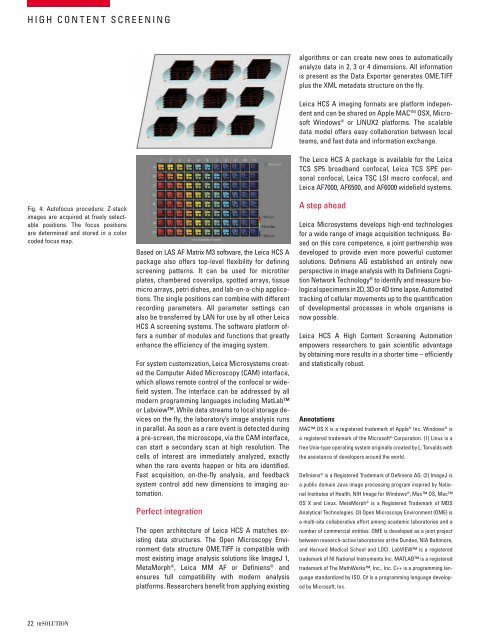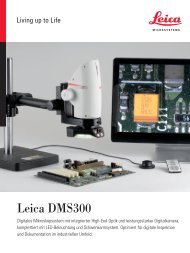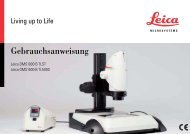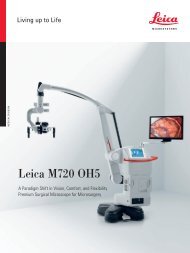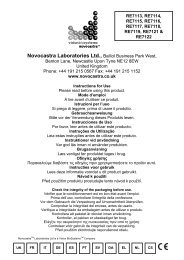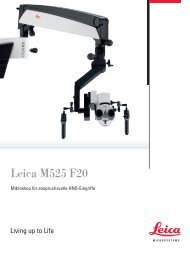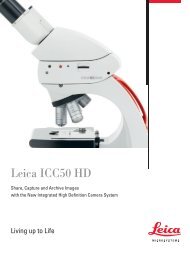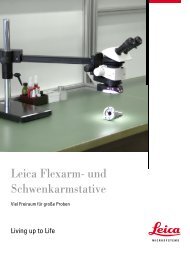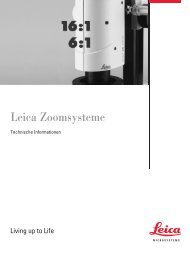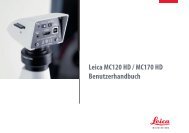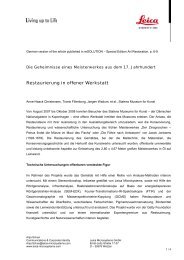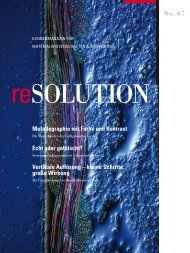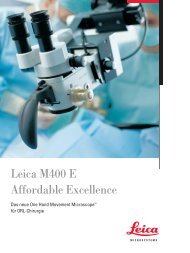reSOLUTION_Research_09_Neuroscience - Leica Microsystems
reSOLUTION_Research_09_Neuroscience - Leica Microsystems
reSOLUTION_Research_09_Neuroscience - Leica Microsystems
Create successful ePaper yourself
Turn your PDF publications into a flip-book with our unique Google optimized e-Paper software.
HigH content screening<br />
fig. 4: autofocus procedure: z-stack<br />
images are acquired at freely selectable<br />
positions. the focus positions<br />
are determined and stored in a color<br />
coded focus map.<br />
22 resolutioN<br />
based on las af matrix m3 software, the leica Hcs a<br />
package also offers top-level flexibility for defining<br />
screening patterns. it can be used for microtiter<br />
plates, chambered coverslips, spotted arrays, tissue<br />
micro arrays, petri dishes, and lab-on-a-chip applications.<br />
the single positions can combine with different<br />
recording parameters. all parameter settings can<br />
also be transferred by lan for use by all other leica<br />
Hcs a screening systems. the software platform offers<br />
a number of modules and functions that greatly<br />
enhance the efficiency of the imaging system.<br />
for system customization, leica microsystems created<br />
the computer aided microscopy (cam) interface,<br />
which allows remote control of the confocal or widefield<br />
system. the interface can be addressed by all<br />
modern programming languages including matlab<br />
or labview. While data streams to local storage devices<br />
on the fly, the laboratory’s image analysis runs<br />
in parallel. as soon as a rare event is detected during<br />
a pre-screen, the microscope, via the cam interface,<br />
can start a secondary scan at high resolution. the<br />
cells of interest are immediately analyzed, exactly<br />
when the rare events happen or hits are identified.<br />
fast acquisition, on-the-fly analysis, and feedback<br />
system control add new dimensions to imaging automation.<br />
Perfect integration<br />
the open architecture of leica Hcs a matches existing<br />
data structures. the open microscopy environment<br />
data structure ome.tiff is compatible with<br />
most existing image analysis solutions like imageJ 1,<br />
metamorph ® , leica mm af or definiens ® and<br />
ensures full compatibility with modern analysis<br />
platforms. researchers benefit from applying existing<br />
algorithms or can create new ones to automatically<br />
analyze data in 2, 3 or 4 dimensions. all information<br />
is present as the data exporter generates ome.tiff<br />
plus the Xml metadata structure on the fly.<br />
leica Hcs a imaging formats are platform independent<br />
and can be shared on apple mac tm osX, microsoft<br />
Windows ® or linuX2 platforms. the scalable<br />
data model offers easy collaboration between local<br />
teams, and fast data and information exchange.<br />
the leica Hcs a package is available for the leica<br />
tcs sP5 broadband confocal, leica tcs sPe personal<br />
confocal, leica tsc lsi macro confocal, and<br />
leica af7000, af6500, and af6000 widefield systems.<br />
a step ahead<br />
leica microsystems develops high-end technologies<br />
for a wide range of image acquisition techniques. based<br />
on this core competence, a joint partnership was<br />
developed to provide even more powerful customer<br />
solutions. definiens ag established an entirely new<br />
perspective in image analysis with its definiens cognition<br />
network technology ® to identify and measure biological<br />
specimens in 2d, 3d or 4d time lapse. automated<br />
tracking of cellular movements up to the quantification<br />
of developmental processes in whole organisms is<br />
now possible.<br />
leica Hcs a High content screening automation<br />
empowers researchers to gain scientific advantage<br />
by obtaining more results in a shorter time – efficiently<br />
and statistically robust.<br />
Annotations<br />
mac os X is a registered trademark of apple ® inc. Windows ® is<br />
a registered trademark of the microsoft ® corporation. (1) linux is a<br />
free unix-type operating system originally created by l. torvalds with<br />
the assistance of developers around the world.<br />
definiens ® is a registered trademark of definiens ag. (2) imageJ is<br />
a public domain Java image processing program inspired by national<br />
institutes of Health, niH image for Windows ® , mac os, mac<br />
os X and linux. metamorph ® is a registered trademark of mds<br />
analytical technologies. (3) open microscopy environment (ome) is<br />
a multi-site collaborative effort among academic laboratories and a<br />
number of commercial entities. ome is developed as a joint project<br />
between research-active laboratories at the dundee, nia baltimore,<br />
and Harvard medical school and loci. labVieW is a registered<br />
trademark of ni national instruments inc. matlab is a registered<br />
trademark of the mathWorks, inc., inc. c++ is a programming language<br />
standardized by iso. c# is a programming language developed<br />
by microsoft, inc.


